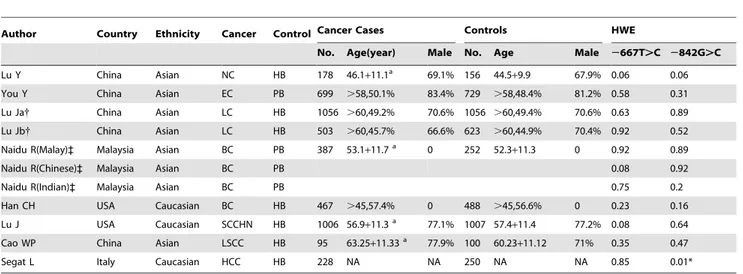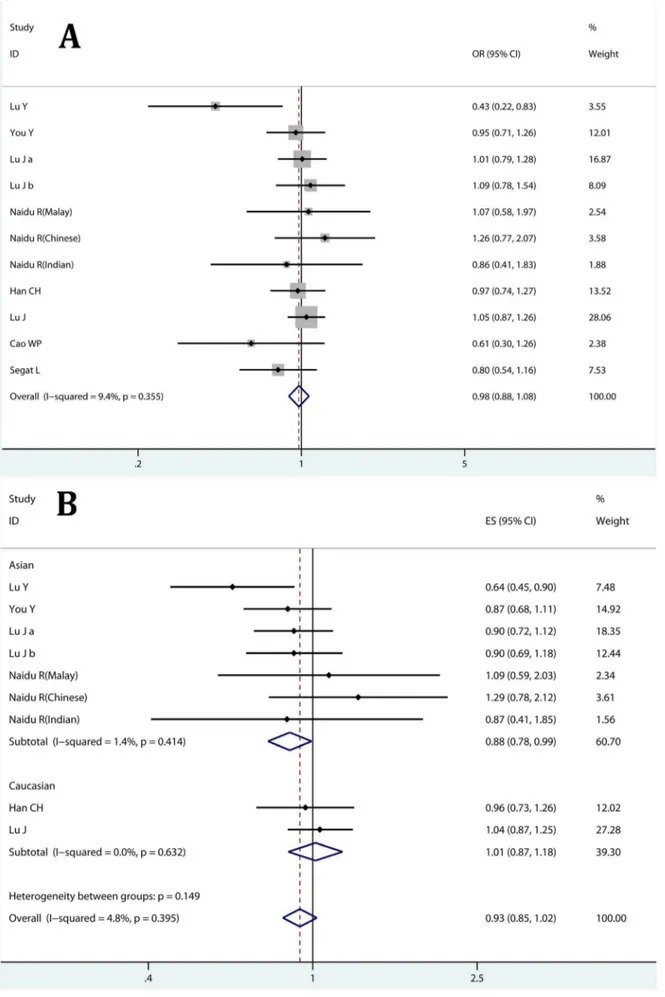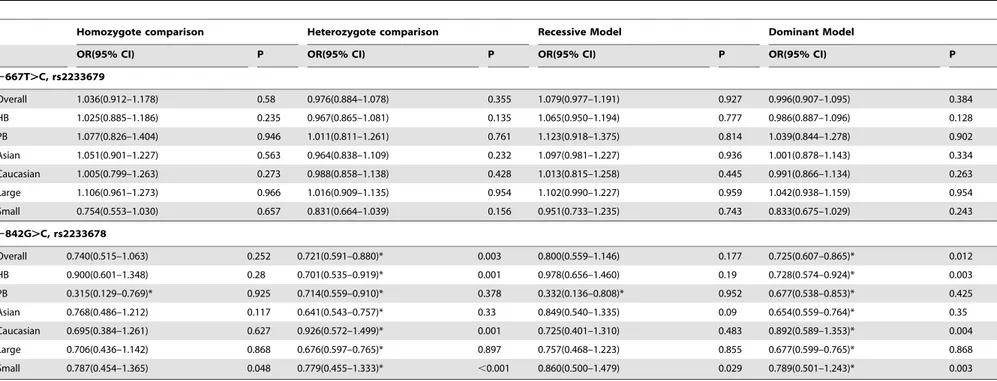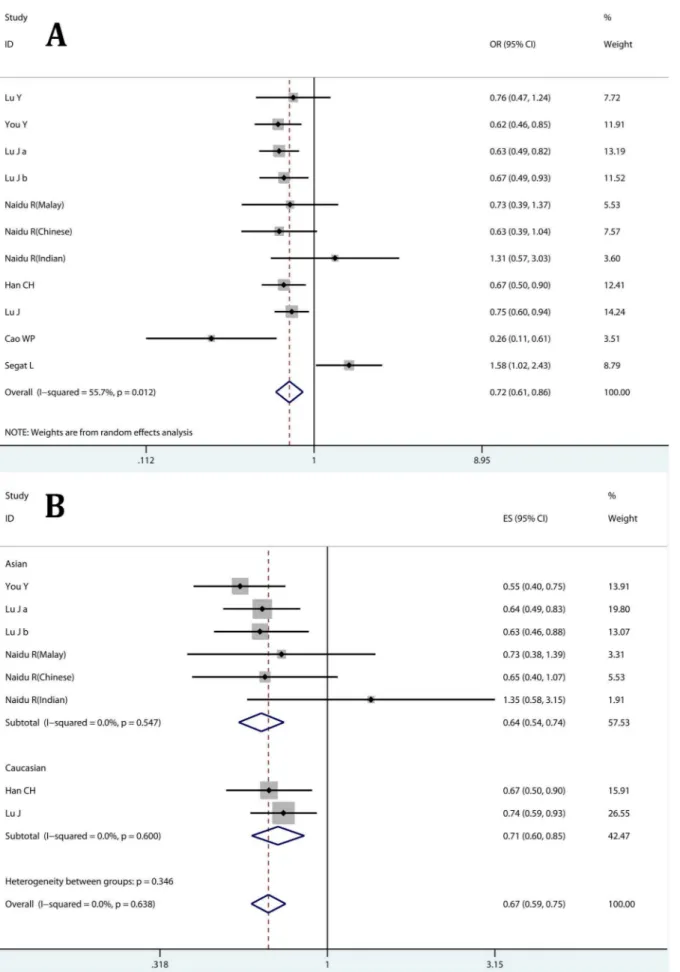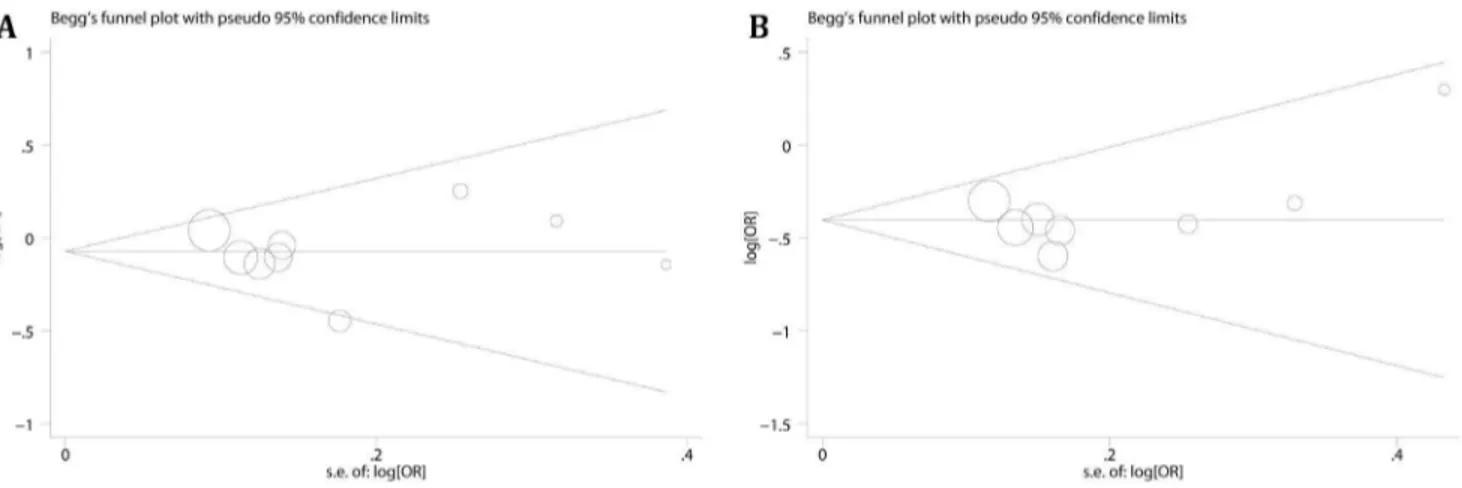Single Nucleotide Polymorphisms of PIN1 Promoter
Region and Cancer Risk: Evidence from a Meta-Analysis
Jing-Jing Peng, Dong Wei, Dong Li, Zeng-Qiang Fu, Yong Tan, Tao Xu, Jing-Jun Zhou, Tao Zhang*
Department of Oncology, the General Hospital of Chengdu Military District, Chengdu, Sichuan, P.R. China
Abstract
Background:Peptidylprolyl cis/trans isomerase NIMA-interacting 1 (PIN1) is involved in the process of tumorigenesis. The two single nucleotide polymorphisms (2677T.C,2842G.C) in the PIN1 promoter region have been suspected of being associated with cancer risk for years, but the conclusion is still inconclusive.
Methods:Eligible case-control studies were retrieved by searching databases and references of related reviews and studies. Genotype distribution data, adjusted odds ratios (ORs) and 95% confidence (CIs) intervals were extracted to calculate pooled ORs.
Results:A total of 4619 cancer cases and 4661 controls were included in this meta-analysis. Overall, the PIN12667T.C polymorphism was not associated with cancer risk, while the2842C allele was significantly associated with reduced cancer risk (CC+GC vs. GG, OR = 0.725, 95% CI: 0.607–0.865; Pheterogeneity= 0.012 and GC vs. GG: OR = 0.721, 95% CI: 0.591–0.880; Pheterogeneity= 0.003). Results from genotype distribution data were in agreement with those calculated with adjusted ORs and 95% CIs. No publication bias was detected.
Conclusions:Results of this meta-analysis suggest that the PIN12842G.C polymorphism is associated with decreased cancer risk, but that the2667T.C polymorphism is not.
Citation:Peng J-J, Wei D, Li D, Fu Z-Q, Tan Y, et al. (2013) Single Nucleotide Polymorphisms of PIN1 Promoter Region and Cancer Risk: Evidence from a Meta-Analysis. PLoS ONE 8(8): e70990. doi:10.1371/journal.pone.0070990
Editor:Oliver Schildgen, Kliniken der Stadt Ko¨ln gGmbH, Germany ReceivedJune 7, 2013;AcceptedJuly 1, 2013;PublishedAugust 16, 2013
Copyright:ß2013 Peng et al. This is an open-access article distributed under the terms of the Creative Commons Attribution License, which permits unrestricted use, distribution, and reproduction in any medium, provided the original author and source are credited.
Funding:The authors have no support or funding to report.
Competing Interests:The authors have declared that no competing interests exist. * E-mail: zhangtcd@163.com
Introduction
Peptidylprolyl cis/trans isomerase NIMA-interacting 1 (PIN1) belongs to the parvulin peptidyl-prolyl isomerase family. With a conserved WW (Trp-Trp) domain, which is responsible for binding to specific sequences of target proteins and recruiting these proteins into signaling complexes [1,2]. PIN1 has a high affinity to proteins with Ser/Thr-Pro (Proline) motifs and regulates the conformation of pro-directed phosphorylation sites [2,3]. Pro-directed phosphorylation is a critical signaling mechanism that regulates various biological processes, such as cell proliferation, differentiation, transcriptional regulation and tumorigenesis [4]. Thus, PIN1 can regulate a lot of signaling pathways including those responsible for tumorigenesis [5] by modulating pro-directed phosphorylation. It has been well demonstrated that numerous oncogenic and tumor suppressor proteins are regulated by PIN1, such as cyclin D1 [6], c-Jun [7], Bcl-2 [8],b-catenin [9] and p53 [10]. Therefore, PIN1 functions as a critical regulator during the process of tumorigenesis.
Consistent with the critical regulatory role of PIN1 in cancer development, it has been reported that aberrant expression of PIN1 is associated with cancers, such as breast cancer [7,11] and prostate cancer [12]. Additionally, studies suggest that single nucleotide polymorphisms (SNPs) of PIN1 are associated with Alzheimer’s disease [13,14] and cancer [15–22]. The two SNPs
(2667T.C rs2233679,2842G.C rs2233678) in the promoter region of PIN1 have been mostly investigated. In 2007, Segat and colleagues [21] found the2667T.C polymorphism was associ-ated with hepatocelluar carcinoma (HCC) that was co-infected with hepatitis B virus and hepatitis B virus; however, other researchers did not found any significant association of THE 2667T.C polymorphism with other cancers [16,17]. On the other hand, Han et al [16] showed that the C allele of the 2842G.C polymorphism could reduced the risk of breast cancer, while Naidu suggested that the2842G.C polymorphism did not affect susceptibility to breast cancer [20]. Briefly, the association of the two SNPs of PIN1 (2667T.C,2842G.C) with cancer risks is elusive according to current literatures.
The present meta-analysis was designed to ascertain whether the two common SNPs (2667T.C, 2842G.C) of PIN1 are associated with cancer risk and evaluate the impact of ethnicities.
Methods
Searching strategy
were also considered. There was no limitation of search and the last search was performed on March, 2013. Reference lists of related studies and reviews were manually searched for additional studies.
Inclusion and exclusion criteria
Eligible studies were identified according to the following inclusion criteria: (1) case-control studies; (2) investigating the correlation between the2842G.C or2667T.C polymorphism and cancer risk; (3) providing detail genotype frequencies. Studies without detail genotype frequencies were excluded. Searching records were primarily searched by titles and abstracts and then full text articles were retrieved for further evaluation of eligibility. Two reviewers (PJJ and WD) extracted eligible studies indepen-dently according to the inclusion criteria. Disagreement between two authors was discussed with another author (ZT) till consensus was achieved.
Data Collection
Data of eligible studies was extracted by two authors (PJJ and WD) independently in duplicate with a predesigned data-collection form. The following data was collected: name of first author, year of publication, country where the study was conducted, genotyping methods, ethnicity, cancer type, source of
control, number of cases and controls, genotype frequency in cases and controls, adjusted odds ratios (ORs) and 95% confidence intervals (CIs). In this meta-analysis, ethnicity was simply categorized as Asian and Caucasian. Source of control was defined as hospital-based (HB) and population-based (PB) accord-ing to the control source. Sample size of studies were defined as large (.500 participants) or small (#500 participants). In the study by Segat et al [21], no information about control source was available, thus we classified this study as HB. Two reviewers reached consensus on each item.
Statistical analysis
To test the distribution of Hardy-Winberg equilibrium (HWE) in controls, chi-square test for goodness of fit was conducted and a p,0.05 indicated disequilibrium of HWE. We assessed the association strength of the PIN1 2667T.C and 2842G.C polymorphisms with cancer risk by OR and 95% CIs. The 95% CIs was used for statistical significance test and a 95% CI without 1 indicating a significantly increased or decreased cancer risk. We calculated pooled ORs for homozygote comparison (CC vs. TT or GG), heterozygote comparison (TC vs. TT and GC vs. GG), dominant model (TC+CC vs. TT or GC+CC vs. GG) and recessive (CC vs. GC+GG or TC+TT) model, assuming the dominant and recessive effect of the variant C allele, respectively.
Figure 1. Flow Diagram.*Data from Lu [18] were treated as 2 studies, and data from Naidu [20] were treated as 3 studies. doi:10.1371/journal.pone.0070990.g001
PIN1 Polymorphisms Increase Cancer Risk
We performed subgroup analyses to explore the effects of confounding factors, such as ethnicities, source of control and sample size. By omitting one study each time, sensitivity analyses were performed to investigate individual study’ effect on pooled results and test the reliability of meta-analysis results.
Chi-square based Q test was utilized to assess the statistical heterogeneity between studies, and heterogeneity was significant when p,0.10. The fixed-effects model (based on Mantel-Haenszel method) and random-effects model (based on DerSimonian-Laird method) were used to calculated the pooled ORs. The fixed-effects model was used when there was no significant heterogeneity; otherwise, the random-effects model was applied [23]. Meta-regression was performed to detect the source of heterogeneity, and a p,0.05 was considered significant.
Begg’s funnel plot and the Egger’ linear regression test were conducted to detect publication bias, and a p,0.05 was considered significant [24]. All statistical analyses were conducted with STATA software (version 10.0; StataCorp, College Station, Texas USA). And all p values are two-side.
Results
Identification of eligible studies
After removal of duplicated records, a number of 91 searching records were screened and 8 full-text articles [15–22] were retrieved after primary screening. In the study by Naidu et al [20], they investigated three populations and the genotype distribution were reported separately, therefore, the three populations were regarded as 3 studies; Lu also reported data of test set and validation set independently [18], and the two sets were treated as 2 studies. Thus, 11 studies were included in the quantitative synthesis. The detailed screening process was shown in Figure 1.
Characteristics of included studies
A total of 11 studies were included in this meta-analysis, including 4619 cancer patients and 4661 controls. PIN1 polymorphisms and cancer risk was investigated in 7 kinds of cancer (hepatocellular carcinoma, laryngeal squamous cell
carci-noma, squamous cell carcinoma of the head and neck, breast cancer, lung cancer, esophageal carcinoma and nasopharyngeal carcinoma). Polymerase chain reaction–restriction fragment length polymorphism (PCR-RFLP) was used for genotyping in most studies. The detailed characteristics of eligible studies are shown in Table 1. Genotype distributions of the 2667T.C and 2842G.C polymorphism in controls were in agreement with HWE, except for the 2842G.C polymorphism in the study reported by Segat and colleagues [21].
2677T.C polymorphism and cancer risk
By pooling data of genotype distribution, in overall comparison, no significant association of the2667T.C polymorphism with cancer risk was found in any comparison model (Figure 2A; Table 2). Subgroup analyses were conducted to further evaluate the impact of ethnicities, sources of control and sample size. Results suggested that there was no significant association of the 2667T.C polymorphism with cancer risk in any of the subgroups (Table 2). Notably, no significant heterogeneity among studies was detected (Table 2). Sensitivity analysis revealed that no individual study affected the pooled results significantly (data not shown).
To better assess the effect of PIN1 polymorphisms, we calculate pooled OR with adjusted ORs and 95% CIs. Similarly, we found the PIN12667T.C polymorphism did not contribute to cancer risk in overall comparison (Figure 2B; Table 3). However, Asian carriers of the 2667TC genotype may have a reduced risk of cancer (Heterozygote comparison TC vs. CC: OR = 0.880, 95% CI: 0.779–0.993; Pheterogeneity,0.414; Table 3), while this was not
observed in Caucasian population. Heterogeneity was not significant among studies and no individual study significantly affected the pooled results.
PIN12842G.C polymorphism and cancer risk
Meta-analysis results from genotype distribution data showed that the 2842C allele could significantly reduced cancer risk (Dominant model CC+GC vs. GG: OR = 0.725, 95% CI: 0.607– 0.865; Pheterogeneity= 0.012 Figure 3A; and Heterozygote
compar-Table 1.Characteristics of 11 eligible studies.
Author Country Ethnicity Cancer Control Cancer Cases Controls HWE
No. Age(year) Male No. Age Male 2667T.C 2842G.C
Lu Y China Asian NC HB 178 46.1+11.1a 69.1% 156 44.5+9.9 67.9% 0.06 0.06
You Y China Asian EC PB 699 .58,50.1% 83.4% 729 .58,48.4% 81.2% 0.58 0.31
Lu Ja{ China Asian LC HB 1056 .60,49.2% 70.6% 1056 .60,49.4% 70.6% 0.63 0.89
Lu Jb{ China Asian LC HB 503 .60,45.7% 66.6% 623 .60,44.9% 70.4% 0.92 0.52
Naidu R(Malay)` Malaysia Asian BC PB 387 53.1+11.7a 0 252 52.3
+11.3 0 0.92 0.89
Naidu R(Chinese)` Malaysia Asian BC PB 0.08 0.92
Naidu R(Indian)` Malaysia Asian BC PB 0.75 0.2
Han CH USA Caucasian BC HB 467 .45,57.4% 0 488 .45,56.6% 0 0.23 0.16
Lu J USA Caucasian SCCHN HB 1006 56.9+11.3a 77.1% 1007 57.4
+11.4 77.2% 0.08 0.64
Cao WP China Asian LSCC HB 95 63.25+11.33a 77.9% 100 60.23+11.12 71% 0.35 0.47
Segat L Italy Caucasian HCC HB 228 NA NA 250 NA NA 0.85 0.01*
HB: hospital-based; PB: population-based; PCR-RFLP: polymerase chain reaction-restricted fligment length polymorphism; HWE: Hardy-Winberg Equibrilium; NA: not available; NC: nasopharyngeal carcinoma; EC: esophageal carcinoma; LC: lung cancer; BC: breast cancer; SCCHN: squamous cell carcinoma of the head and neck; LSCC: laryngeal squamous cell carcinoma; HCC: hepatocellular carcinoma; a: mean+standard devation;{the study by Lu J [18] was treated as two studies, Lu Ja: test set, Lu Jb: validation set;`in the study by Naidu R [20], each population was considered as a study.
doi:10.1371/journal.pone.0070990.t001
Figure 2. Correlation between the PIN12667T.C polymorphism and cancer risk.A: heterozygote comparison (TC vs. TT) estimated with genotype distribution data; B heterozygote comparison (TC vs. TT) calculated with adjusted ORs and 95% CIs; Lu J a: test set [18]; Lu J b: validation set [18]. doi:10.1371/journal.pone.0070990.g002
PIN1 Polymorphisms Increase Cancer Risk
Table 2.Association of PIN1 polymorphisms with cancer risk estimated with raw data.
Homozygote comparison Heterozygote comparison Recessive Model Dominant Model
OR(95% CI) P OR(95% CI) P OR(95% CI) P OR(95% CI) P
2667T.C, rs2233679
Overall 1.036(0.912–1.178) 0.58 0.976(0.884–1.078) 0.355 1.079(0.977–1.191) 0.927 0.996(0.907–1.095) 0.384
HB 1.025(0.885–1.186) 0.235 0.967(0.865–1.081) 0.135 1.065(0.950–1.194) 0.777 0.986(0.887–1.096) 0.128
PB 1.077(0.826–1.404) 0.946 1.011(0.811–1.261) 0.761 1.123(0.918–1.375) 0.814 1.039(0.844–1.278) 0.902
Asian 1.051(0.901–1.227) 0.563 0.964(0.838–1.109) 0.232 1.097(0.981–1.227) 0.936 1.001(0.878–1.143) 0.334
Caucasian 1.005(0.799–1.263) 0.273 0.988(0.858–1.138) 0.428 1.013(0.815–1.258) 0.445 0.991(0.866–1.134) 0.263
Large 1.106(0.961–1.273) 0.966 1.016(0.909–1.135) 0.954 1.102(0.990–1.227) 0.959 1.042(0.938–1.159) 0.954
Small 0.754(0.553–1.030) 0.657 0.831(0.664–1.039) 0.156 0.951(0.733–1.235) 0.743 0.833(0.675–1.029) 0.243
2842G.C, rs2233678
Overall 0.740(0.515–1.063) 0.252 0.721(0.591–0.880)* 0.003 0.800(0.559–1.146) 0.177 0.725(0.607–0.865)* 0.012
HB 0.900(0.601–1.348) 0.28 0.701(0.535–0.919)* 0.001 0.978(0.656–1.460) 0.19 0.728(0.574–0.924)* 0.003
PB 0.315(0.129–0.769)* 0.925 0.714(0.559–0.910)* 0.378 0.332(0.136–0.808)* 0.952 0.677(0.538–0.853)* 0.425
Asian 0.768(0.486–1.212) 0.117 0.641(0.543–0.757)* 0.33 0.849(0.540–1.335) 0.09 0.654(0.559–0.764)* 0.35
Caucasian 0.695(0.384–1.261) 0.627 0.926(0.572–1.499)* 0.001 0.725(0.401–1.310) 0.483 0.892(0.589–1.353)* 0.004
Large 0.706(0.436–1.142) 0.868 0.676(0.597–0.765)* 0.897 0.757(0.468–1.223) 0.855 0.677(0.599–0.765)* 0.868
Small 0.787(0.454–1.365) 0.048 0.779(0.455–1.333)* ,0.001 0.860(0.500–1.479) 0.029 0.789(0.501–1.243)* 0.003
OR: odds ratio; P: p value of heterogeneity; HB: hospital-based; PB: population-based; *significant association. doi:10.1371/journal.pone.0070990.t002
PIN1
Polymorp
hisms
Increase
Cancer
Risk
PLOS
ONE
|
www.ploson
e.org
5
August
2013
|
Volume
8
|
Issue
8
|
ison: GC vs. GG: OR = 0.721, 95% CI: 0.591–0.880, P heterogene-ity= 0.003; Table 2). The decreased cancer risk was also confirmed
subgroup analyses (Table 2). Sensitivity analysis suggested no individual study affected pooled result significantly, while hetero-geneity among studies was observed.
When assessing the2842G.C polymorphism and cancer risk using adjusted ORs and 95% CIs, we found the2842C allele was associated with a decreased risk in all 3 comparison models and most subgroups (Figure 3B; Table 3). Additionally, no significant heterogeneity was observed and no individual study affected the pooled results.
Publication bias and meta-regression
Publication bias were evaluated by Egger’s test and Begg’s test, and we did not found any evidence of publication bias (Figure 4, heterozygote comparison of 2667T.C and dominant model of 2842G.C were given for example). To search the source of heterogeneity, meta-regression was performed. Cancer types (p = 0.003), ethnicities (p = 0.001), sources of control (p = 0.006) and sample size (p = 0.001) were the sources of heterogeneity. Additionally, study by Segat [21] also contributed to heterogeneity (p = 0.015), and no significant heterogeneity (Heterozygote com-parison, Pheterogeneity= 0.418; Dominant model, P heterogene-ity= 0.455) was observed after removal of this study.
Discussions
Human PIN1 gene, located on chromosome 19p13, contains 4 exons and has a promoter region of about 1.5 kb. The2667T.C and 2842G.C polymorphisms occur in PIN1 promoter region, and they have been suspected as risk factors of cancer [16,17,21] and Alzihamer’s disease [13,14]. Recently, data from a meta-analysis showed that neither the 2667T.C nor 2842G.C polymorphism was associated with susceptibility to Alzihamer’s
disease [25]; however, the correlation between PIN1 polymor-phisms and cancer risk is still inconclusive.
In this meta-analysis, we found the2667T.C polymorphism did not contribute to susceptibility to cancer, while the2842C allele was significantly associated with reduced risk of cancer. To better evaluate the effect of PIN1 polymorphisms, adjusted ORs and CIs from eligible studies were collected and analyzed. These findings were also supported by results from adjusted ORs. Additionally, results from adjusted ORs also suggested that carriers of the2667TC genotype may have a decreased cancer risk in Asian.
Lu and colleagues [17] have demonstrated that the 2842C allele of PIN1 is associated with reduced transcriptional activity. Combined with the oncogenetic role of PIN1 [18], this may explain why the 2842C allele reduced cancer risk. Segat first reported that2667T allele was associated with increased risk of HCC co-infected with HBV and HCV [21], while subsequent studies did not found any differences between the 2667T and 2667C allele [3,13,24]. In the study by Segat [21], a set of highly selected patients were included, and they could not represent all HCC. In addition, the genotype distribution of2842G.C was in disagreement with HWE, which may be the reason why they found an increased risk.
Heterogeneity was observed in the heterozygote comparison and dominant model of2842G.C polymorphism. The hetero-geneity among studies was caused by cancer types, sources of control, ethnicities and sample size. Additionally, in terms of individual study, Segat’s study [21] contributed to heterogeneity, but sensitivity analysis revealed that this study did not affect the pooled results significantly. Thus, results from our meta-analyses were robust and reliable.
It has been well documented that meta-analysis increases in statistical power [26] and various studies have validated the Table 3.Association of PIN1 polymorphisms with cancer risk estimated with adjusted ORs and 95% CIs.
Homozygote comparison Heterozygote comparison Dominant Model
OR(95% CI) P OR(95% CI) P OR(95% CI) P
2667T.C, rs2233679
Overall 1.100(0.957–1.265) 0.491 0.931(0.847–1.023) 0.395
HB 1.093(0.929–1.285) 0.133 0.925(0.831–1.030) 0.187
PB 1.122(0.853–1.477) 0.95 0.949(0.777–1.159) 0.535
Asian 1.105(0.933–1.308) 0.323 0.880(0.779–0.993)* 0.414
Caucasian 1.091(0.851–1.398) 0.503 1.015(0.873–1.180) 0.632
Large 1.152(0.994–1.335) 0.938 0.946(0.853–1.048) 0.766
Small 0.735(0.475–1.138) 0.396 0.849(0.665–1.084) 0.115
2842G.C, rs2233678
Overall 0.589(0.394–0.880)* 0.885 0.664(0.590–0.747)* 0.527 0.668(0.594–0.751)* 0.638
HB 0.682(0.435–1.069) 0.901 0.665(0.582–0.761)* 0.681 0.678(0.593–0.776)* 0.812
PB 0.327(0.133–0.804)* 0.905 0.660(0.516–0.842)* 0.188 0.636(0.502–0.806)* 0.26
Asian 0.486(0.292–0.810)* 0.896 0.632(0.542–0.738)* 0.442 0.636(0.545–0.742)* 0.547
Caucasian 0.806(0.419–1.550) 0.956 0.710(0.592–0.850)* 0.55 0.713(0.596–0.853)* 0.6
Large 0.720(0.442–1.173) 0.938 0.656(0.578–0.745)* 0.682 0.656(0.580–0.743)* 0.663
Small 0.386(0.190–0.784)* 0.837 0.715(0.521–0.982)* 0.208 0.768(0.537–1.098) 0.346
OR: odds ratio; P: p value of heterogeneity; HB: hospital-based; PB: population-based; *significant association. doi:10.1371/journal.pone.0070990.t003
PIN1 Polymorphisms Increase Cancer Risk
Figure 3. Association of PIN12843G.C polymorphism with cancer risk.A: dominant model (GC+CC vs. GG) calculated with genotype
distribution data; B dominant model (GC+CC vs. GG) calculated with adjusted ORs and 95% CIs; Lu J a: test set [18]; Lu J b: validation set [18].
doi:10.1371/journal.pone.0070990.g003
efficacy of meta-analysis [27,28]. In this meta-analysis, we included 4619 cancer cases and 4661 controls, which can provide enough statistical power. We also calculated pooled ORs with adjusted ORs and CIs, which could more precisely reflect gene effect. Also, limitations of this study should be noted. This meta-analysis was based on studies of different kinds of cancer, thus it should be caution to interpret our results. Because of the varied etiology of cancer, these 2 SNPs of PIN1 may have different functions according to cancer types. Additionally, due to limited number of studies, we did not performed subgroup analyses according to cancer types.
To summary, we demonstrate that the 2667T.C polymor-phism of the PIN1 do not contribute to cancer risk, while the 2842C allele is associated with reduced cancer risk.
Supporting Information
Checklist S1 PRISMA checklist. (DOC)
Author Contributions
Conceived and designed the experiments: JJP DW JJZ TZ. Performed the experiments: JJP DW DL ZQF YT TX JJZ ZT. Analyzed the data: JJP DW DL ZQF ZT. Contributed reagents/materials/analysis tools: JJP DW DL ZQF YT TX JJZ TZ. Wrote the paper: JJP DW TZ.
References
1. Lu KP, Hanes SD, Hunter T (1996) A human peptidyl-prolyl isomerase essential for regulation of mitosis. Nature 380: 544–547.
2. Ranganathan R, Lu KP, Hunter T, Noel JP (1997) Structural and functional analysis of the mitotic rotamase Pin1 suggests substrate recognition is phosphorylation dependent. Cell 89: 875–886.
3. Zhou XZ, Lu PJ, Wulf G, Lu KP (1999) Phosphorylation-dependent prolyl isomerization: a novel signaling regulatory mechanism. Cell Mol Life Sci 56: 788–806.
4. Lu KP (2003) Prolyl isomerase Pin1 as a molecular target for cancer diagnostics and therapeutics. Cancer Cell 4: 175–180.
5. Ryo A, Liou YC, Lu KP, Wulf G (2003) Prolyl isomerase Pin1: a catalyst for oncogenesis and a potential therapeutic target in cancer. J Cell Sci 116: 773– 783.
6. Miyashita H, Mori S, Motegi K, Fukumoto M, Uchida T (2003) Pin1 is overexpressed in oral squamous cell carcinoma and its levels correlate with cyclin D1 overexpression. Oncol Rep 10: 455–461.
7. Wulf GM, Ryo A, Wulf GG, Lee SW, Niu T, et al. (2001) Pin1 is overexpressed in breast cancer and cooperates with Ras signaling in increasing the transcriptional activity of c-Jun towards cyclin D1. EMBO J 20: 3459–3472. 8. Pathan N, Aime-Sempe C, Kitada S, Basu A, Haldar S, et al. (2001)
Microtubule-targeting drugs induce bcl-2 phosphorylation and association with Pin1. Neoplasia 3: 550–559.
9. Ryo A, Nakamura M, Wulf G, Liou YC, Lu KP (2001) Pin1 regulates turnover and subcellular localization of beta-catenin by inhibiting its interaction with APC. Nat Cell Biol 3: 793–801.
10. Wulf G, Finn G, Suizu F, Lu KP (2005) Phosphorylation-specific prolyl isomerization: is there an underlying theme? Nat Cell Biol 7: 435–441. 11. Lam PB, Burga LN, Wu BP, Hofstatter EW, Lu KP, et al. (2008) Prolyl
isomerase Pin1 is highly expressed in Her2-positive breast cancer and regulates erbB2 protein stability. Mol Cancer 7: 91.
12. Ayala G, Wang D, Wulf G, Frolov A, Li R, et al. (2003) The prolyl isomerase Pin1 is a novel prognostic marker in human prostate cancer. Cancer Res 63: 6244–6251.
13. Segat L, Pontillo A, Annoni G, Trabattoni D, Vergani C, et al. (2007) PIN1 promoter polymorphisms are associated with Alzheimer’s disease. Neurobiol Aging 28: 69–74.
14. Lambert JC, Bensemain F, Chapuis J, Cottel D, Amouyel P (2006) Association study of the PIN1 gene with Alzheimer’s disease. Neurosci Lett 402: 259–261. 15. Cao W, Ruan H, Tang H, Ling P (2012) Association between polymorphisms in
prolyl isomerase Pin1 and the risk for laryngeal squamous cell carcinoma. Jiangsu Medical Journal 38: 1067–1070.
16. Han CH, Lu J, Wei Q, Bondy ML, Brewster AM, et al. (2010) The functional promoter polymorphism (2842G.C) in the PIN1 gene is associated with decreased risk of breast cancer in non-Hispanic white women 55 years and younger. Breast Cancer Res Treat 122: 243–249.
17. Lu J, Hu Z, Wei S, Wang LE, Liu Z, et al. (2009) A novel functional variant (2842G.C) in the PIN1 promoter contributes to decreased risk of squamous cell carcinoma of the head and neck by diminishing the promoter activity. Carcinogenesis 30: 1717–1721.
18. Lu J, Yang L, Zhao H, Liu B, Li Y, et al. (2011) The polymorphism and haplotypes of PIN1 gene are associated with the risk of lung cancer in Southern and Eastern Chinese populations. Hum Mutat 32: 1299–1308.
19. Lu Y, Huang GL, Pu XX, He YX, Li BB, et al. (2012) Association between PIN1 promoter polymorphisms and risk of nasopharyngeal carcinoma. Mol Biol Rep.
20. Naidu R, Har YC, Taib NA (2011) Analysis of peptidyl-propyl-cis/trans isomerase 1 (PIN1) gene2842(G.C) and2667(T.C) polymorphic variants in relation to breast cancer risk and clinico-pathological parameters. Scand J Clin Lab Invest 71: 500–506.
21. Segat L, Milanese M, Crovella S (2007) Pin1 promoter polymorphisms in hepatocellular carcinoma patients. Gastroenterology 132: 2618–2619; author reply 2619–2620.
22. You Y, Deng J, Zheng J, Jiang L, Li N, et al. (2013) Functional polymorphisms in PIN1 promoter and esophageal carcinoma susceptibility in Chinese population. Mol Biol Rep 40: 829–838.
23. DerSimonian R, Laird N (1986) Meta-analysis in clinical trials. Control Clin Trials 7: 177–188.
Figure 4. Funnel plots for2667T.C and2842G.C polymorphism.A: heterozygote comparison (TC vs. TT) of2667T.C polymorphism estimated with adjusted ORs and 95% CIs, PBegg= 0.917, PEgger= 0.89; B: dominant model (GC+CC vs. GG) of2842G.C polymorphism calculated with adjusted ORs, PBegg= 0.536, PEgger= 0.366.
doi:10.1371/journal.pone.0070990.g004
PIN1 Polymorphisms Increase Cancer Risk
24. Egger M, Davey Smith G, Schneider M, Minder C (1997) Bias in meta-analysis detected by a simple, graphical test. BMJ 315: 629–634.
25. Cao L, Wang F, Ge H, Wu PC, Qu P, et al. (2013) PIN1-842G/C and2667T/ C polymorphisms are not associated with the susceptibility of Alzheimer’s disease: Pooled analysis of epidemiologic studies. Neurosci Lett 535: 100–103. 26. Cohn LD, Becker BJ (2003) How meta-analysis increases statistical power.
Psychol Methods 8: 243–53.
27. Ding Q, Shi Y, Fan B, Fan Z, Ding L, et al. (2013) The interleukin-10 promoter polymorphism rs1800872 (2592C.A), contributes to cancer susceptibility: meta-analysis of 16,785 cases and 19,713 controls. PLoS ONE 8: e57246. 28. Ye Z, Song H, Higgins JP, Pharoah P, Danesh J (2006) Five glutathione
s-transferase gene variants in 23,452 cases of lung cancer and 30,397 controls: meta-analysis of 130 studies. PLoS Med 3: e91.
![Figure 1. Flow Diagram. *Data from Lu [18] were treated as 2 studies, and data from Naidu [20] were treated as 3 studies.](https://thumb-eu.123doks.com/thumbv2/123dok_br/18396141.358134/2.918.91.598.86.642/figure-flow-diagram-treated-studies-naidu-treated-studies.webp)
